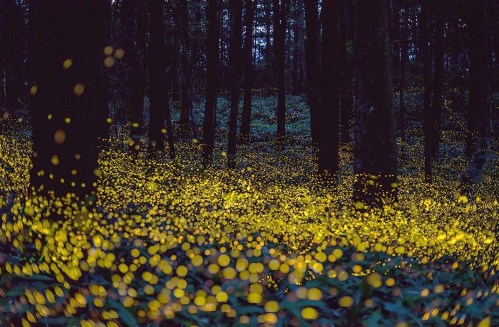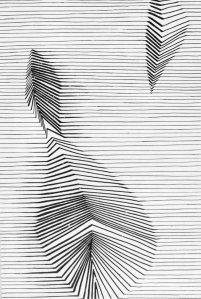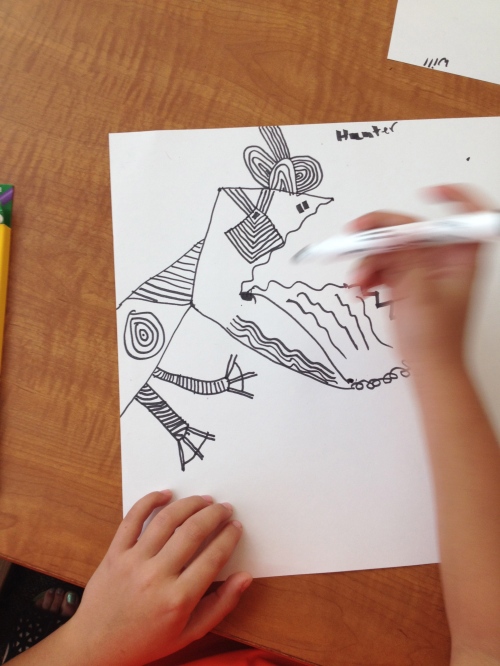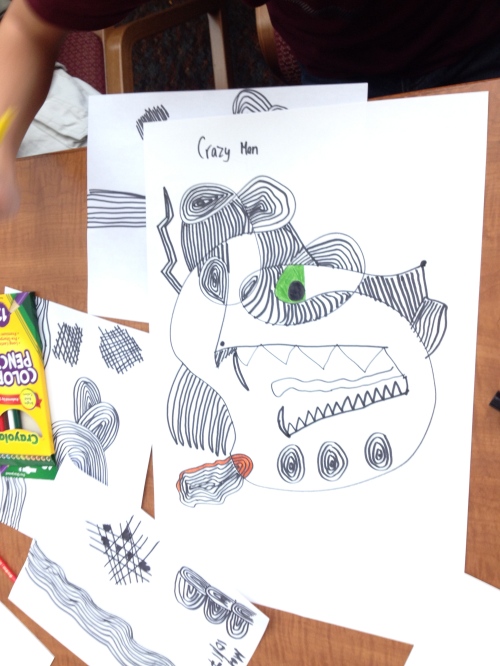 Noticing cobblestones – the wonderful patterns, a few stones missing….
Noticing cobblestones – the wonderful patterns, a few stones missing….
When I was teaching at Vermont College of Fine Arts, I often asked my students to begin their semester with me by telling me where their attention had come to rest recently. This usually produced blank stares, and I had to further explain: I was asking them to tell me what turned their heads, what had they been looking at and noticing recently, what pulled at them so hard that they couldn’t walk past it, what bit of information had come in randomly which they couldn’t let go of, what compelled them to pause and wonder, what made them investigate further.
 Began noticing clouds, began looking up photos of terrifying clouds.
Began noticing clouds, began looking up photos of terrifying clouds.
I didn’t want anything philosophical, at least not at the surface level, and I didn’t want to hear about anything they were using for a current creative project. I just wanted to hear about physical objects or facts about the real world – where their “attention came to rest” that had little to do with anything else they were involved with. This would help me as a teacher, not only to see how well they could articulate their quirks and idiosyncrasies (and tangentially, to see if they could handle prose) but to open up a conversation about obsessions – my having come to the conclusion early on that artists are, in general, obsessive about unusual things.
 Began to collect old photos of long-gone orchards.
Began to collect old photos of long-gone orchards.
 Sigh. Another ghost orchard.
Sigh. Another ghost orchard.
I also thought that once students noticed what they were noticing, they would begin to see patterns emerge, and patterns could tell them a lot about who they were as artists in the world.
 Patterns everywhere, even in stacks of firewood…
Patterns everywhere, even in stacks of firewood…
If my students remained confused, I offered examples of my own: I once bought an old postcard of handkerchiefs in a store window. I found the postcard at a Paper Ephemera fair and couldn’t put it down. A whole storefront window full of handkerchiefs on display: so unusual, so marvelous! Even thinking of it now fills me with pleasure. That was something I could not just “walk past” – I bought that postcard.
Another example: the Plague.
 The Plague – I couldn’t get enough of it. The more gruesome, the better.
The Plague – I couldn’t get enough of it. The more gruesome, the better.
I developed a fascination with the Black Death – how it spread across Europe in the 14th century. I had a whole stack of books checked out of the library. I looked up primary documents from the time, I researched art work – simple woodcuts sometimes, or complicated images of it in religious iconography and architectural decoration. My obsession with it was feverish – I needed to learn more about something horrible and mysterious, something that I had only a marginal interest in until it suddenly grabbed hold of me and would not let go.
 Shiny jars and lids turned my head…
Shiny jars and lids turned my head…
That kind of thing – that was what I was asking students about. Once explained, the writing exercise took off – most students provided me with fine descriptions of all kinds of unusual things, and they were glad to be reflecting on the question. But for some students – quite a few more than I anticipated – even the explanation and the examples were not enough.
 as did a small man on a large vase…
as did a small man on a large vase…
It seemed impossible to me that they were not stopped in their tracks by anything – that their unique perspective on gazing (from which place “voice” comes) never made them catch their breath and STOP. So I looked for a more plausible explanation: was it possible that they were unaware of what caught and held them – were they not paying attention to what they paid attention to?
 and the twenty days of the Zapotec calendar: crocodile, lightning, shredded meat, deer, water, knot, monkey, loofah, heart, cornstalk, eye, thunder, humid, drip, lord…plus a few question marks.
and the twenty days of the Zapotec calendar: crocodile, lightning, shredded meat, deer, water, knot, monkey, loofah, heart, cornstalk, eye, thunder, humid, drip, lord…plus a few question marks.
I think that’s dangerous territory for someone who wants to write – a lack of attention to your own physical responses to the things of this world, and an inability to list (inarticulate as that list might prove to be) what you’ve been noticing.
 Couldn’t get enough of this camel, either. Especially those lips. Looked up “camel” in the encyclopedia. Lots to know.
Couldn’t get enough of this camel, either. Especially those lips. Looked up “camel” in the encyclopedia. Lots to know.
The photos I’m inserting into this post are of things that caught and held my attention this year. I might not be able to articulate the “why” behind my fascination – sometimes it seems to be a simple aesthetic response, sometimes my gaze turns to an object at an instinctive level, sometimes it’s quite clearly intellectual. But I do like to try to ponder the puzzle of what caught me in the first place.
 Looked up “fireflies,” too.
Looked up “fireflies,” too.
If you haven’t been noticing what you notice, try taking a simple digital camera with you (or use the camera on your phone) whenever you go out, and make a record of anything that turns your head and makes you pause.
 Patterns, even in popsicles.
Patterns, even in popsicles.
Reflect on it, think through what the fascination is. With those handkerchiefs, so beautifully displayed in that vintage photo, the effect was one of tremendous grace, similar to the effect on me recently of an organ played in the great cathedral of Mexico City. Angels sang, and up the song rose, up into the domed ceiling, echoing around, filling me up.
 What is it about watercolor paint tins? So messy. So gorgeous.
What is it about watercolor paint tins? So messy. So gorgeous.
That sounds absurd. Or maybe not. Maybe someday that window full of hankies will make their way into a poem. For now, I’m only grateful for getting swept off my feet by that photo. Linen hankies – a whole huge window full. Angels sang.
 Abraham & Straus Department Store, Brooklyn, circa 1895.
Abraham & Straus Department Store, Brooklyn, circa 1895.
————————————————————————————–
It’s Poetry Friday again, and I have some thoughts about wandering and coming home (as a follow-up to my post here on August 29th about a planned trip to Oaxaca) plus a favorite poem by Nelson Bentley, over at The Drift Record today. To head over there, click here.
 I elaborated on that line. You have to spend time on art to be able to express yourself. It takes practice and hard work and a kind of perfectionism. But it also takes imperfectionism and playfulness, especially when an idea is first developing. And you have to look inside and outside of yourself.
I elaborated on that line. You have to spend time on art to be able to express yourself. It takes practice and hard work and a kind of perfectionism. But it also takes imperfectionism and playfulness, especially when an idea is first developing. And you have to look inside and outside of yourself. Half of my time there was spent giving art classes. These schools do not have art teachers or art rooms so we worked in the libraries or lunch rooms. The lack of art education in the world feeds the idea that people are either good or bad at art. I wanted to have a project that allowed for success and showed that everyone can make art. But I didn’t want a formula – I wanted each child’s work to be unique.
Half of my time there was spent giving art classes. These schools do not have art teachers or art rooms so we worked in the libraries or lunch rooms. The lack of art education in the world feeds the idea that people are either good or bad at art. I wanted to have a project that allowed for success and showed that everyone can make art. But I didn’t want a formula – I wanted each child’s work to be unique.
















































